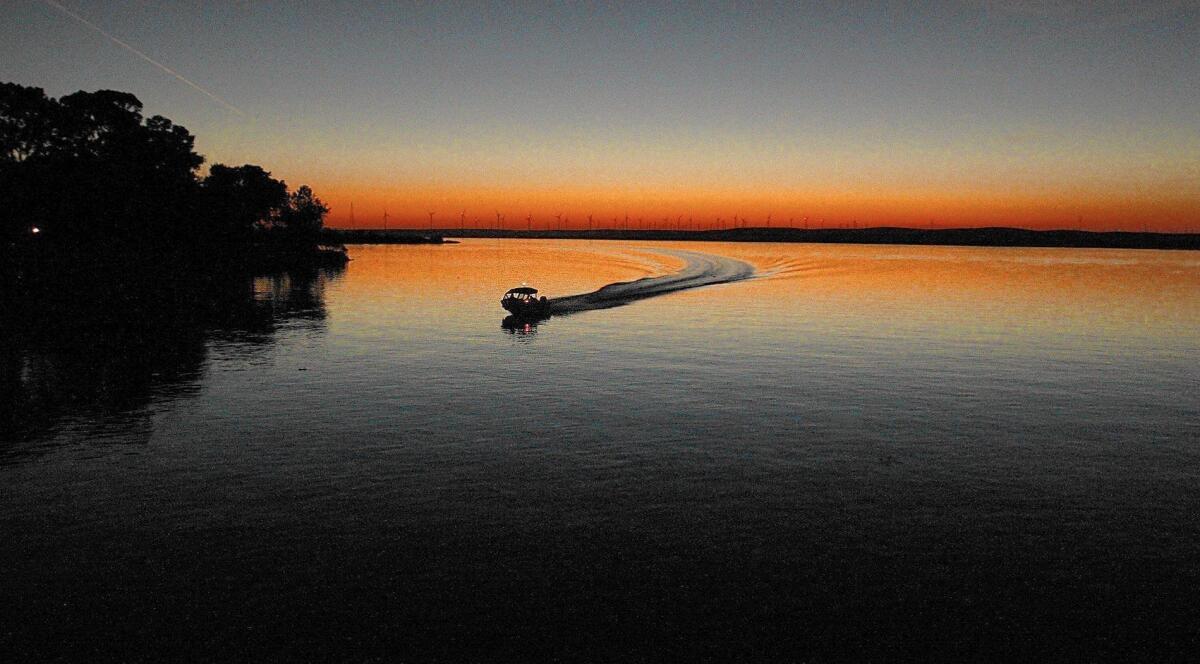Column: On delta tunnel, Newsom should heed Dirty Harry’s sound advice

- Share via
SACRAMENTO — To paraphrase Clint Eastwood’s Dirty Harry in the 1973 movie classic “Magnum Force,” a governor’s got to know his limitations.
There are limits to the power even of a governor with no major political opposition and a very friendly, normally cooperative Legislature.
This time, Gov. Gavin Newsom may have found his limitations. Key lawmakers are pushing back against his late-entry legislation to expedite construction of a highly controversial water tunnel under the Sacramento-San Joaquin River Delta.
As is his pattern, Newsom is trying to jam through the legislation at the last minute, denying legislators and the public ample time to assess and debate the proposal. That really ticks off lawmakers, whether they’re leaders or backbenchers.
“It feels disrespectful to the [legislative] process,” state Sen. Susan Talamantes Eggman (D-Stockton) said at a Senate committee hearing on the governor’s proposal this month.
“To try to force something through at the last minute like this on such a controversial issue, it’s so inappropriate,” Assemblyman Carlos Villapudua (D-Stockton) says.
Newsom did that last year and later bragged about his success in jamming the lawmakers. Near the end of its two-year session, the governor sent the Legislature an ambitious package of climate-fighting proposals, and most of it passed.
A governor can “jam” legislators by holding their bills hostage. He might refuse to sign a bill authored by a lawmaker who votes against his proposal. By waiting so long to send his bills to the Legislature, a governor also greatly reduces the time opponents have to organize opposition.
This year, Newsom waited until May 19 to propose sketchy infrastructure legislation that he asked lawmakers to pass within five weeks as part of the annual state budget. What he proposed has nothing to do with the budget. But he can hold legislators’ pet budget items hostage to their votes for his proposal
Also the governor’s legislation can be dumped into budget “trailer” bills that don’t need to go through scrutiny by policy committees.
Newsom proposed a sweeping package of 11 bills that would make it easier to build clean energy, transportation and water projects, including the delta tunnel.
It would do this, essentially, by cutting corners on environmental protection. Lawsuits filed under the 1970 California Environmental Quality Act would need to be wrapped up in 270 days, unless a judge found that to be unfeasible. Now such lawsuits can drag on for years.
Concerning the tunnel, the vote necessary for approval by a key delta oversight committee would be reduced. Protections for endangered wintering sandhill cranes would be loosened. And local interests’ role in designing the tunnel would be reduced, they fear.
Governors for six decades have tried to build this project in some form or another and been beaten back by grassroots activists or state voters.
The delta is California’s main water hub, serving 27 million people and irrigating 3 million acres.
“It’s the backbone of our state water system,” says Wade Crowfoot, secretary of the state Natural Resources Agency. “We’re on borrowed time in the delta. It has a major vulnerability to saltwater intrusion with the risk of sea rise in climate change. And there’s earthquake risk.
“We can’t continue year after year to be in legal limbo as a result of litigation. Let’s figure out how we can streamline the litigation and give thumbs up or thumbs down” on the tunnel.
And if it’s thumbs down, he says, then the state can “get back to the drawing board and another approach.”
Project opponents — especially delta residents, including farmers — contend that future saltwater intrusion is one reason the tunnel shouldn’t be built. It would siphon water out of the fresher north delta before it could flow through the more saline southern end as it does now, pushing back salt water intruding from San Francisco Bay.
The saltier water would be disastrous for Stockton, smaller delta communities and farming, opponents say.
As for the earthquake threat, no temblor has ever damaged a delta levee and there are no major faults under the estuary. Anyway, couldn’t a major quake damage an underground tunnel?
The fishing industry and boaters fear that reducing freshwater flows through the delta will decimate salmon runs and worsen toxic algae that clog waterways in summer.
“The whole system has crashed” for salmon, says Barry Nelson, a consultant for the Golden State Salmon Assn. That’s partly because of giant south delta fish-chomping pumps and government regulations that often deprive baby salmon of strong enough water flows as they try to migrate out to sea.
“The tunnel would allow the [state] to dramatically increase pumping from the Sacramento River system and further decrease the salmon population,” Nelson says.
That would depend on how the tunnel is regulated. But there’s no trust of government regulators among tunnel opponents.
Villapudua drafted a letter to Newsom and legislative leaders signed by 10 lawmakers of both parties asking that tunnel project be removed from the governor’s package.
“It wasn’t very wise to include the delta,” says Sen. John Laird (D-Santa Cruz), a former natural resources secretary who helped push then-Gov. Jerry Brown’s failed twin-tunnel project.
“A $16-billion project like [the tunnel] will likely have significant impacts on a large, ecologically sensitive and important area. Something of that scale should not be fast-tracked through an environmental review process.”
Oh, yes. The cost: Virtually everyone knows the price of that 45-mile, 39-foot-wide tunnel would be much more than advertised. And so far there isn’t even financing for it. Water users would pay.
Newsom should listen to Dirty Harry.
More to Read
Sign up for Essential California
The most important California stories and recommendations in your inbox every morning.
You may occasionally receive promotional content from the Los Angeles Times.











